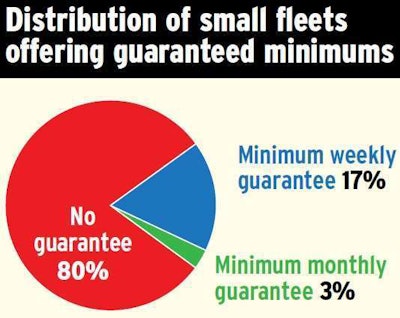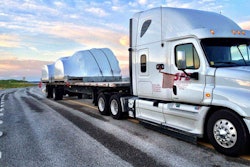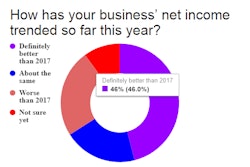Previously in this series: Guaranteed pay: The promise for company drivers, small fleets
Twenty percent of the small fleet respondents to Overdrive’s recent compensation survey offered minimum guaranteed-pay packages to employed drivers. The rate is slightly higher than what drivers report in the same survey, where 17 percent said they receive a minimum guarantee.
Small fleets are showing an eagerness to experiment with guaranteed pay. Of those that have established such a program, 83 percent did so within the last five years, though 67 percent have done so within just the last two years.
 Among small-fleet-owner respondents to the survey, 76 percent owned one to five trucks, 10 percent owned six to 10, and 14 percent owned more than 10. Other insights from small-fleet owner-operator respondents to Overdrive’s compensation survey:
Among small-fleet-owner respondents to the survey, 76 percent owned one to five trucks, 10 percent owned six to 10, and 14 percent owned more than 10. Other insights from small-fleet owner-operator respondents to Overdrive’s compensation survey:• A majority (56 percent) paid operators primarily based on a percentage of the load. 36 percent used a per-mile rate.
• 56 percent had raised drivers’ base rate of pay at least once within the last two years, 16 percent more than once.
• Gross pay averaged less than or equal to $60,000 for drivers at 48 percent of the fleets, more at the rest.
Still, minimum guarantees aren’t for everyone. Small fleet operator Mark White of Old Time Express, started by his owner-operator father, Bo, in Hartsville, Tennessee, considered guaranteed pay for the fleet of about 20 trucks. While it “sounds good in theory,” White says, “there’s just too much incentive to do less.”
Efforts to improve retention and the driver experience at the dry box hauler have centered instead on detention and benefits, among other things. As of about a year ago, White and company are picking up 100 percent of drivers’ health insurance premiums, rather than the typical split on offer at companies around the nation.
When White’s company shifted to electronic logs several years ago, “I thought about switching to hourly-based pay,” he says. “We kicked that around — it might be difficult unless we went to an hourly-based charge to our customers,” something few carriers outside of local haulers are doing today.
Smokey Point Distributing had similar worries about its move toward offering an annual guaranteed salary for company flatbed haulers. Comfort enough to make the move was achieved with an internal system for analysis, as well as incentives for miles and hazmat/overdimensional hauls the company allowed on top of the base salary.
Developers built a way to analyze haulers involved in the company’s test of its minimum-guarantee system, Smokey Point’s Dan Wirkkala said in May. Productivity increased, contrary to “what’s often expected” for non-piece-rate structures. Wirkkala acknowledges a trucking company might “get itself into trouble if they don’t have the right tools in place and the ability to measure” productivity metrics in near-real time.
“This industry is full of smoke and mirrors” as it relates to driver pay. “Everybody in the fleet has a predictable income but the truck driver, and it’s just wrong.” –Smokey Point Distributing CEO Dan Wirkkala on the rationale behind his company’s move to base salaried pay for drivers
Osbourne Logistics, says Brant Osbourne, similarly tracks performance in its flat daily pay scheme. It’s been rare that a driver underperforms, and when it pops up, it’s typically just one of many reasons a driver isn’t cut out for Osbourne Logistics, which has seen more drivers hit the one- and two-year anniversary with the company since it started the program.
Drivers on Smokey Point’s program “get paid on 9,900 miles a month regardless of productivity,” Wirkkala says. If drivers aren’t hitting the mark “due to company performance … we eat that, a big risk that we take on our end.” That also gives office personnel their own kind of incentive to perform.
The current strong market makes it “a good time to implement this,” he says. “The true test: How well do we do when things get tight and everybody’s undercutting each other?”
Time will tell. —Linda Longton contributed to this report.
More recent reporting from Overdrive‘s 2018 compensation survey:
The feast or famine of owner-operator income, in good times and bad
Income distribution with/without an independent dispatcher, and service-evaluation tips











